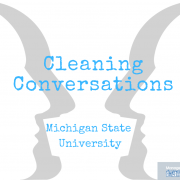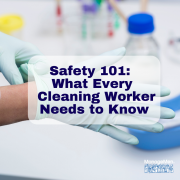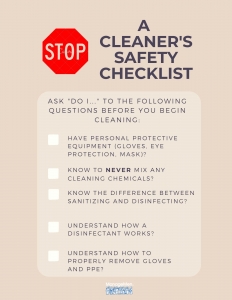In This Together: Tips for Coordinating Cleaning as Buildings Reopen
“We’re in this together” is a frequent refrain of the past two months. From the pandemic to protests, people share these words to express solidarity and unity throughout the many challenges facing our communities right now.
Within the Simon Institute, (OS1) leaders have been working together throughout the pandemic to share best practices and strategies. However, as federal, state, tribal and local officials in both the public and private sectors move to Opening Up America again, it’s time that we expand our cooperation if we haven’t already.
It goes without saying that we play a critical role in the effort to protect the people who live, work in and visit the buildings we clean. In fact, the U.S. EPA has recently issued a statement emphasizing the need to continue cleaning and disinfection practices to reduce exposure to the virus that causes COVID-19.
But we can’t do this alone. Through ongoing communication and effective partnerships with key stakeholders, we can work together to keep buildings clean and disinfected. Click here to read the full blog post that identifies who would should be talking to right now and what we should be discussing.
WHO: Administration
WHAT TO DISCUSS: Organizations want additional cleaning, but many are not adjusting their scope of services and budgets accordingly. Custodial professionals should be prepared to have conversations about the need for additional resources. This includes being able to identify costs associated with additional cleaning products, labor, PPE and training to ensure buildings are cleaned in a way that keeps everyone safe.
WHO: Internal Reopening Teams
Teams might include facility managers, safety directors, human resources, marketing and other key administrative professionals within the organization.
WHAT TO DISCUSS: Make sure your team is involved in helping coordinate efforts as buildings reopen. In these meetings, you’ll want to communicate plans for staffing, cleaning frequencies and any resources you have available through existing supply chain relationships. This might include access to wipes, hand sanitizer and additional cleaning products.
You might also work with marketing and communications to help create communication tools for building occupants.
WHO: Building occupants
WHAT TO DISCUSS: When clearly communicating cleaning programs with building occupants, you not only help build peace of mind, but you can also help improve the effectiveness of cleaning programs.
Topics to address may include:
- Any disinfectant/wipes sharing programs to assist in cleaning personal spaces
- Highlights of the (OS1) System and approach
- Specific high-touch areas located throughout the building
- Dust control initiatives, which limit the potential for the virus that causes COVID-19 to remain suspended in the air by attachment
- Requests to clean off desks, conference tables and other surfaces in communal areas to improve cleaning effectiveness
WHO: Distributors
WHAT TO DISCUSS: As a general rule of thumb, you want to avoid overstocking and plan on two units (or two full orders) of critical inventory for consumables, chemicals, and tools. This includes germicidal cleaner, vacuum filters, and pro-duster sleeves. Distributors in the industry have experienced extreme disruption with shortages of supply. Many of the raw materials that we rely upon in the United States come from China – and since China has been experiencing their own pandemic-related challenges, it’s been hard to get those raw materials. Things that we take for granted – plastice bottles, spray nozzles, even microfiber in some instances are going to have longer lead times for the next few months. Stocking up now, and maintaining a lean, but effective inventory will help your operation reduce its overall impact on supply.
Ongoing communication is critical as we work together to keep our buildings safe and healthy for everyone.




